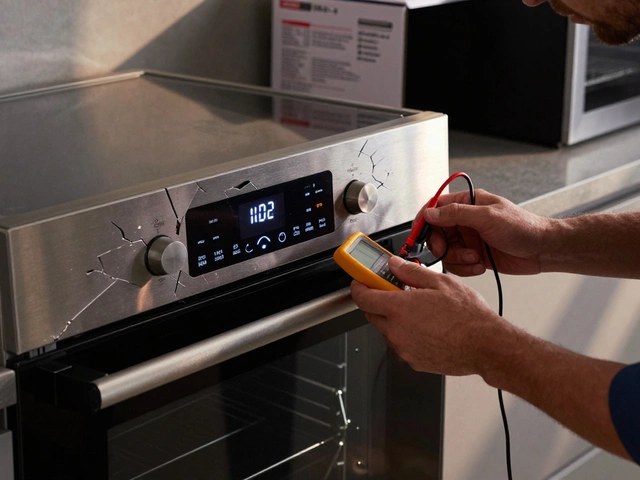Extractor fans are the unsung heroes of our kitchens and bathrooms. They quietly keep the air fresh and moisture-free, preventing mold and lingering smells. But what happens when your trusty fan starts acting up? Don’t worry—most of the time, it's something you can fix yourself before resorting to a costly professional service. Let’s dive into some common problems and how to troubleshoot them.
First off, you’ll want to identify the issue. Is your fan making weird noises, or has it stopped working entirely? Maybe it's just not pulling air like it used to. These are all signals that something’s wrong. Grab a screwdriver and a flashlight, and let's get to it!
Common Issues
Before diving into repairs, let’s talk about some of the most common problems your extractor fan might face. Understanding what's wrong is half the battle won.
Fan Not Working
The most obvious issue is when the fan won’t turn on. This usually indicates an electrical problem. Check to make sure the fan is plugged in and that the circuit breaker hasn't tripped. You might also want to inspect the wiring for any loose connections.
Noisy Operation
If your fan sounds like it's about to take off, it probably needs some TLC. Accumulated dust or debris could be interfering with the blades. A thorough cleaning might just do the trick. Additionally, check for loose parts that might be rattling around.
Weak Airflow
When your fan doesn’t seem to be pulling air as effectively as it used to, first check to see if the vent is blocked. Dust, lint, and other debris can accumulate over time, so regular cleaning is essential. Also, ensure that the exhaust path isn't blocked.
Bad Smells
If an unpleasant odor emanates every time you switch the fan on, it could be due to mold or mildew in the ductwork. Inspect this area carefully and clean it as necessary. Sometimes replacing the filter can make all the difference.
General Maintenance Tips
- Regularly clean the fan blades to avoid dust buildup.
- If your fan has a filter, change it as recommended by the manufacturer.
- Ensure the exhaust vent is free from obstructions both inside and outside.
| Issue | Possible Cause | Solution |
|---|---|---|
| Fan Not Working | Electrical Problem | Check wiring, circuit breaker |
| Noisy Operation | Dust/Debris | Clean fan blades, check for loose parts |
| Weak Airflow | Blocked Vent | Clean vent, check exhaust path |
| Bad Smells | Mold/Mildew | Clean ductwork, replace filter |
By keeping these common problems in mind and following some regular maintenance tips, you can prolong the life of your extractor fan and ensure it operates smoothly.
Tools You Need
Before you roll up your sleeves and fix your extractor fan, gather a few essential tools. Having the right stuff on hand makes the job way easier and quicker.
Basic Tools
Just like any other DIY job, you’ll need a trusty screwdriver. A flathead and a Phillips should cover most screws you’ll encounter. Don’t have them? You’re missing out on some of the most versatile tools ever.
Safety Gear
Don’t forget your safety goggles and gloves. A splinter or an electric shock isn’t part of the plan, right? Safety’s key when you’re dealing with anything electrical.
"Safety first is safety always." - Charles M. Hayes
Electrical Tools
A multimeter is your best friend if you suspect electrical issues. This tool checks for electrical continuity, so you can see whether the problem is in the wiring or the extractor fan itself. If you don't own one, they're an awesome investment for any aspiring DIYer.
Optional Tools
- Portable Light: You might need a strong lamp or flashlight to see into dark corners, like attic spaces or above the kitchen range.
- Vacuum or Compressed Air: Help clear out dust or any debris that might be clogging up the system.
So, grab these tools and let’s get ready to dive into the heart of your problem. Remember, having all these tools doesn’t mean you’ll use them every time. But it’s always better to be prepared!

Step-by-Step Troubleshooting
Alright, let’s roll up our sleeves and get to the nitty-gritty of fixing your extractor fan. Before you start, always make sure the power is off to avoid any unwanted shocks.
Check for Power Issues
The first thing you want to do is check if the issue is with the power supply. Ensure that the circuit breaker hasn’t tripped and that the switch works. Use a multimeter to check the voltage at the fan wires if you're comfortable with it.
Inspect and Clean the Fan Blades
Dirt and grime can build up on the blades, making the fan work less efficiently. Carefully remove the fan cover and inspect the blades. If they're dirty, a simple clean might do wonders. Use a damp cloth to wipe them down.
Listen for Noises
If your fan is buzzing or rattling, check if anything is obstructing the blades. Tighten any loose screws or mounts, as vibrations from these can cause unwanted noise.
Check for Blockages in the Ventilation
No airflow? The vent might be blocked. Remove the duct cover outside your home and inspect the ductwork for any debris or blockages.
Test the Motor
If everything else checks out and the fan still doesn't work, it might be a motor issue. Unfortunately, this might require a replacement motor. At this point, if you're uncomfortable handling electrical components, it might be time to call in a professional.
Here’s a simple table for quick reference on what the problem might be depending on your fan's symptoms:
| Symptom | Possible Issue |
|---|---|
| No power | Check circuit breaker, switch, and wiring |
| Noisy operation | Loose parts, obstructed blades |
| No airflow | Blockage in ducting or vent |
| Intermittent operation | Faulty wiring or switch |
With these steps, you should be well on your way to diagnosing the issue with your extractor fan. Sometimes the solution is simpler than it seems, and a little bit of DIY can save you a lot of money and hassle.
When to Call a Professional
Sometimes, despite your best DIY efforts, it’s time to let the experts take over. Knowing when to call a professional for your extractor fan repair can save both time and stress. Here are some scenarios where you should consider picking up the phone.
Electrical Issues
If your fan shows signs of electrical problems like flickering lights, tripping circuit breakers, or a burning smell, play it safe. Electrical work is no joke and can be dangerous if handled improperly. A licensed electrician can diagnose and fix the issue without risking your safety.
Persistent Noise
Is your fan rattling or humming too loudly even after you've tightened all the screws and cleaned the blades? There could be a deeper mechanical issue at play. Professionals have the tools and expertise to dissect the fan without damaging it.
Poor Airflow
So, you’ve cleaned the vents, replaced the filter, and yet the airflow is still weak. This might be due to an internal blockage or a failing motor. Calling in an expert can help identify and resolve internal problems that are out of reach.
Old Fans
If your fan is ancient and maintaining it becomes a frequent task, it might be both economical and efficient to ask a professional whether replacement is a better option. They can guide you on the best models available today, taking into account energy efficiency and noise levels.
Ace Your Home Inspections
If you’re planning to sell your home, getting a professional to check your extractor fan could save you trouble during inspections. A small investment now could prevent costly last-minute repairs.
Here’s a quick look at some average repair costs:
| Type of Repair | Cost Range |
|---|---|
| Motor Replacement | $150 - $250 |
| Wiring & Electrical | $100 - $200 |
| Thermostat Issues | $120 - $180 |
Remember, knowing when a task is beyond your skills is a skill in itself. Sometimes calling in a specialist is the best move you can make for your peace of mind.









